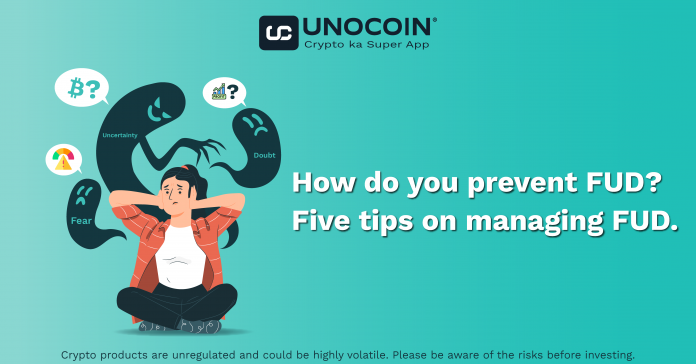When it comes to navigating the cryptocurrency markets, staying informed and avoiding FUD can often be trickier than one might imagine. In this article, we will walk you through how to spot FUD in the blockchain space and how to avoid it.
Since Bitcoin burst onto the scene in 2009, crypto markets have seen their fair share of ups and downs. While it is true that every market downturn has been followed by a recovery and significant development, both experienced and novice traders can find it difficult to navigate during downturns. Especially with the rise of FUD.
Before we focus on business tools to recognize and avoid FUD, let’s first cover what exactly FUD is.
What is FUD?
FUD in cryptocurrency means fear, uncertainty and doubt. This term is used to refer to inaccurate information published by people who want to manipulate the markets. The release of FUD content is intended to influence a trader to make decisions that could somehow affect the price of a cryptocurrency or their investment (usually to encourage them to sell).
While commonly used against Bitcoin, it also targets Ethereum and other cryptocurrencies. FUD usually leads to investors selling their coins, leading to panic selling that snowballs and results in a significant loss in the value of the coin.
The term FOMO, Fear Of Missing Out, is often mentioned alongside FUD. FOMO focuses on people’s fear of missing out, which leads them to make quick decisions that aren’t necessarily the best. While FUD tends to encourage selling an asset, FOMO tends to drive traders to buy an asset. Essentially, these two terms are designed to tap into human emotions that lead to snap decisions.
FUD is usually released through a rumor posted on a well-respected website, negative news, or a well-known figure expressing concern about an asset (commonly done on Twitter). Content around FUD and FOMO tends to come from organizations or individuals who stand to gain something from the intended action. The content is designed to strongly influence the reader.
FUD and FOMO are not strictly related to the crypto market, such tactics have also been witnessed in the stock market and other commodity trading spaces. Jargon has become synonymous with trading.
How to spot FUD
The crypto community may seem tight-knit, but there are often bad actors who gain access to a trusted space and infiltrate it with bad news. This is often seen when people use a commonly discussed topic like regulation to create a story that is not necessarily true to influence traders.
Here are some tips to ensure you don’t fall victim to FUD:
Set a business goal
Before entering the crypto market, make sure you have definite goals with accompanying timelines. When you encounter FUD or FOMO information, consider whether the resulting actions of the messages will move you closer to or further from your goal. If you stay focused on your goal, you are less likely to be swayed by market sentiment.
Create a trading strategy before entering a trade
A trading strategy generally involves determining a stop loss, an entry point, a target sell point, and the amount of capital. By establishing this before entering a trade, you will have clear goals to pursue and be less likely to fall victim to FUD misinformation.
Stay informed, but verify sources
Monitoring the crypto markets and staying informed is a must for every trader, especially day traders. Make sure the places you’re getting information from are trustworthy and legitimate, and if something sounds suspicious, check with a number of other sources.
Be patient and consistent
Cryptocurrency trading is not a get-rich-quick scheme, instead, it is about making well-educated trades based on market movements and investing in technologies you believe in. Don’t get caught up in trying to make a quick buck, instead be patient and consistent in your attempt to reach your original goal and never stray too far from the path.
Navigation FUD
Although it sounds complicated, FUD can be easily avoided if you follow the tips above and only seek information from reliable news sources. While Twitter can have quick tips, it’s also hard to determine what the author’s intentions are.
Consider whether something rings true or not and always do your own research when looking to invest in a new project. Financially, investing in digital currency can be a lucrative endeavor, so be responsible and watch market trends with a grain of salt.
Please find the list of authentic Unocoin accounts for all your queries below:
- YouTube Channel: https://www.youtube.com/c/Unocoin/videos
- Newsletter: https://medium.com/subscribe/@Unocoin_growth
- Blogs: https://blog.unocoin.com
- Instagram: https://www.instagram.com/unocoin/
- Twitter: https://twitter.com/Unocoin
- Facebook: https://www.facebook.com/unocoin/
- LinkedIn: https://in.linkedin.com/company/unocoin
- Telegram Group: https://t.me/Unocoin_Group
- Telegram Channel: https://t.me/+fasQhTKBsfA5N2Zl
- Telegram: https://t.me/UnocoinSupport_Bot
- E-mail id: [email protected]
- Contact details: 7788978910 (09:30 AM IST – 06:30 PM, Mon – Sat)
- App store link: https://apps.apple.com/us/app/unocoin/id1030422972?ls=1
- Playstore link: https://play.google.com/store/apps/details?id=com.unocoin.unocoinwallet
Disclaimer: Crypto products are unregulated as of this date in India. They could be highly volatile. At Unocoin, we understand that there is a need to protect consumer interests as this form of trading and investment has risks that consumers may not be aware of. To ensure that consumers who deal in crypto products are not misled, they are advised to DYOR (Do Your Own Research).




